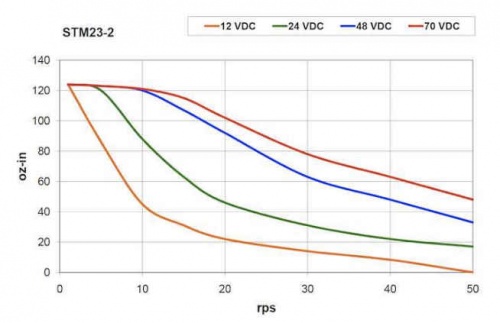Stepper Motor Performance: Difference between revisions
Jump to navigation
Jump to search
No edit summary |
No edit summary |
||
| (4 intermediate revisions by the same user not shown) | |||
| Line 1: | Line 1: | ||
*The higher the voltage - the more torque a motor will have | *The higher the voltage - the more torque a motor will have <ref>https://www.controleng.com/articles/stepper-motor-torque-basics/</ref>: | ||
[[File:steppers-v.jpg]] | [[File:steppers-v.jpg|500px]] | ||
*Ramifications of voltage - one can get higher performance by running at higher voltage. Higher voltage means less current for the same power - so it appears motors run cooler at higher voltage for the same performance. | *Ramifications of voltage - one can get higher performance by running at higher voltage. Higher voltage means less current for the same power - so it appears motors run cooler at higher voltage for the same performance. | ||
*The higher the current - the more torque (T): Torque is proportional to current<ref>https://www.controleng.com/articles/stepper-motor-torque-basics/</ref>. | |||
*Why does a motor have less torque at higher speed? The motor acts as a generator, producing back EMF, reducing the applied voltage. A motor in motion must also overcome inductance of the windings. | |||
=References= | |||
Latest revision as of 02:27, 11 December 2018
- The higher the voltage - the more torque a motor will have [1]:
- Ramifications of voltage - one can get higher performance by running at higher voltage. Higher voltage means less current for the same power - so it appears motors run cooler at higher voltage for the same performance.
- The higher the current - the more torque (T): Torque is proportional to current[2].
- Why does a motor have less torque at higher speed? The motor acts as a generator, producing back EMF, reducing the applied voltage. A motor in motion must also overcome inductance of the windings.
